Text
Bea Wolf, by Zach Weinersmith
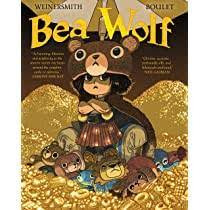
Genre:
Bea Wolf is a middle-grade graphic novel.
Target Age Group:
This book is best for ages 8-12.
Summary:
This graphic novel is modernized retelling of the story of Beowulf, with the titular hero recast as a little girl named Bea, and the villain Grendel as the fun-ruining neighborhood grump, Mr. Grindle.
Justification:
Bea Wolf received starred reviews from School Library Journal, Kirkus Reviews, Booklist, and Publisher's Weekly. I was intrigued because I noticed endorsements from Lemony Snicket and Neil Gaiman (both authors I love), on the cover.
Evaluation:
For this book I will be evaluating language, characters, and illustrations.
Language:
Bea Wolf is a retelling of the Old English story Beowulf. The language is modernized to match the updated plot and setting, but it retains some of the qualities most associated with the original form. The alliteration and cadence of the text both call to mind the style of Beowulf. Some of the language in this book will undoubtedly be challenging for the target audience, much in the same way that the source material can be difficult reading for adults. Context and the illustrations will likely be big helps to younger readers struggling with unfamiliar words. There is a several-page afterward in which the author explains the history and importance of Beowulf and explains how he developed this version.
Characters:
The warriors from the original story take the form of kids in this book. These kids are intensely focused on the world of childhood fun; stashes of Halloween candy, puppies, unsupervised neighborhood shenanigans. They view the worlds of adults and teens as boring and pointless, so their foes are judgmental teens and an adult who is trying to stop their fun. Mr. Grindle is depicted as the worst of adults, boring and bossy, always dressed in a shirt and tie, and opposed to all the things kids love. The characters of the kids are developed enough to make for interesting dynamics between them, and though they are wild and uncivilized, they are also very likable.
Illustrations:
Boulet's black and white sketches are rich in detail and humor. The characters are rendered with exaggerated and expressive features that contribute a lot to the understanding of their thoughts and motives. The action frames are especially impressive for they way they clearly depict complicated sequences involving multiple characters. Everything from the kids' toys, to the monsters they battle, is drawn with imagination and energy, and allows the reader to fully picture the world of Bea Wolf.
I found Bea Wolf to be charming and fun. Like plenty of people I struggled through a complicated translation of the original in a world literature class many years ago, and was not left with a favorable feeling about the book. This version however, is accessible for even grade-schoolers, and full of whimsy and wit. The format makes it a quick read, yet there is enough connection to the source material to give it a feeling of substance.
References
Weinersmith, Z. (2023). Bea Wolf. (G. Boulet, Illus.). First Second.
0 notes
Text
Pizza!: A Slice of History, by Greg Pizzoli
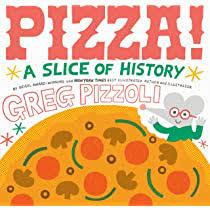
Genre:
Pizza!: A Slice of History is a nonfiction picture book (Texas 2x2 list category).
Target Age Group:
This book is best for children ages 2-8.
Summary:
Pizza is a food enjoyed around the world. This book tells the history of pizza through fun facts and bright, simple artwork.
Justification:
Pizza!: A Slice of History was selected for the 2023 Texas 2x2 list and received enthusiastic reviews from Kirkus, Publisher's Weekly, and Booklist. I was interested in it because Pizzoli's book, The Watermelon Seed has been a very popular Storytime read at my library, and because I cannot resist a picture book with a pun in the title.
Evaluation:
For this book I will be evaluating content, language, and illustrations.
Content:
Pizza!: A Slice of History is surprisingly informative. It touches on historic events that influenced the development and popularization of the dish, and facts about worldwide pizza consumption, giving just enough information to hold one's attention, without boring kids. The range of topics covered makes it likely that most readers will learn something that catches their interest. Finally, there are subtle bits of humor throughout the book, making it a fun read for all ages.
Language:
The language used throughout this book is simple enough for even young listeners to follow the main points, but not simplified to the point of seeming "babyish" to older children or tedious to adults. Definitions of some of the bigger words are incorporated into the text, and the illustrations help to clarify new terms for kids. Text is brief enough to keep the pages turning at a nice attention-holding speed for children. Several pages ask questions of the reader. For instance, after a spread about popular types of pizza in different regions, the book asks, "What is pizza like where you live?" adding a fun interactive component.
Illustrations:
The artwork in Pizza!: A Slice of History is bright and cheerful. There is a limited color palette used, with the majority of pictures rendered in just four, which the copyright page lists as, "sweet-tomato red, fresh-basil green, greasy-cheese yellow, and charred-crust black." The illustrations are simple and the characters look like they could have been taken from a comic strip, down to the speech balloons used for dialogue. The pictures of people depict a diversity of skin tones, ages, and abilities.
I thought this book was very well done and enjoyable. The happy artwork and simple text would make it a good choice for read-alouds with preschoolers, or independent reading for younger grade-schoolers. In fact, I might need to plan an upcoming library Storytime themed around pizza!
References
Pizzoli, G. (2022). Pizza!: A Slice of History. (G. Pizzoli, Illus.). Viking.
1 note
·
View note
Text
Dear Mothman, by Robin Gow
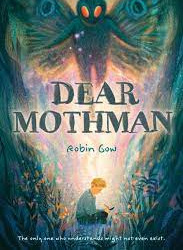
Genre:
Dear Mothman is a middle-grade novel in verse.
Target Age Group:
This book is best for ages 10-14.
Summary:
Sixth-grader Noah is dealing with the grief of losing his best friend Lewis, the only kid he knew who could relate to the mix of emotions he's experiencing since realizing he is transgender. Lewis and Noah were working on a project to prove the existence of the cryptid Mothman, and Noah starts writing letters to Mothman, sharing the thoughts and feelings he's not sure anyone else will understand.
Justification:
Dear Mothman received starred reviews from Booklist and School Library Journal. This title caught my eye because I have always been interested in the Mothman stories.
Evaluation:
For this book I will be evaluating plot, characters, and language.
Plot:
Dear Mothman is an introspective story, and the main action of the plot does not occur until around the last quarter of the book. This is not necessarily a negative thing, but it might be more of a challenge for kids who generally enjoy action-driven plots to get into this story. Much of the storytelling is done through memories, as Noah remembers and processes his friendship with Lewis, and the aftermath of the tragic accident that killed him. The central question Noah sets out to answer, "Is Mothman real?" is not definitively answered in the book, although Hanna and Noah have some experiences that lead them to their own conclusions. However, the real question at the heart of the book is who Noah believes himself to be, and the lessons he learns throughout the story put him well on the path to making decisions about who he does and does not want to become.
Characters:
Noah is sensitive and precocious. He is sometimes hard for the reader to make sense of, which in a way contributed to the story, because much of it is about Noah's struggle to understand himself. Hanna, the other character whose point of view is represented in the book, is more one-dimensional. Even when she is narrating, Hanna's thoughts and actions are nearly all centered on Noah. Noah and Lewis are both transgender, and Hanna identifies as queer. Positive representation for both of these communities at this age-level is still fairly rare, and therefore especially important. Noah and Hanna are the main characters, and all others are mainly background pieces for their experiences.
Language:
The dialogue in this book bothered me a bit. Because Dear Mothman is written in verse, some unusual word choices are to be expected. The lyrical language is also to be expected. What I found distracting was an unevenness in the way the characters speak, and write, to each other. The main characters are in the sixth grade, and sometimes they speak like typical kids; overusing words like "cool" and "awesome", repeatedly inserting "like" as a filler word. Other times they are using uncommon words that one would not expect to find in most sixth-graders' vocabulary, and sophisticated metaphors and similes in everyday conversation. Kids do sometimes surprise us with unexpected wisdom, but many of the instances in this book just felt forced to me.
I enjoyed this story most when it was focused on the kids' plans for the future, both immediate and far-off., because those were the times when the characters seemed best-developed. The plot was unusual and held plenty of surprises, which made for an engaging read. The main thing that pulled me out of the world of the story was when there were unnatural-feeling moments of profundity inserted. There were too many times when a line read like one of those oft-mocked social media posts in which people claim that their young child said something unbelievably advanced for their age. There were many of those to me and I found it quite distracting. On the whole, this was an interesting book, but not as outstanding as I had hoped.
References:
Gow, R. (2023). Dear Mothman. Amulet Books.
0 notes
Text
Scythe, by Neal Shusterman
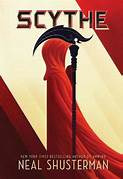
Genre:
Scythe is a YA science fiction book.
Target Age Group:
This story is best for high-school age readers, generally ages 14 and up.
Summary:
In a future world where death has been conquered, Scythes are the select group of people charged with culling humanity to restore balance and prevent overpopulation. Sixteen-year-olds Citra and Rowan have been selected for Scythe training, though neither of them have sought it out, and soon find themselves unwittingly pitted against each other.
Justification:
Scythe is a Printz Honor winner, and a Time "Best YA Book of All Time" pick. It received starred reviews from Kirkus Reviews, and Booklist. I was interested in it because my own teenage sons started reading it based on recommendations from their friends.
Evaluation:
For this book I will be evaluating plot, characters, and setting.
Plot:
Scythe has a unique premise. It has some of the common tropes of the genre; the teenage heroes are pulled into a life-or-death struggle against their will, they are uniquely qualified to save humanity even at their young ages, and they are forced to behave in ways that cause misunderstandings between them. But it also breaks with convention in some impressive ways. For instance, the psychological toll of the extremely stressful situation they are in is addressed head-on, and they actively discuss their dilemmas with their mentors. The main characters are not presented as infallible, they make mistakes and behave in ways they come to regret. One major plot hole to me was the lack of answer to a seemingly obvious question, "Instead of having to kill people to control the population, why do they not focus on stopping people from having children?" This could have been intentional, as a commentary on the effects of overpopulation in the real world, but as there was little discussion of the issue in book, it seems unlikely.
Characters:
Rowan and Citra are likable and relatable characters. They serve as good stand-ins for the reader, as even though they have grown up with the concept of reaping as an accepted part of society, they react with appropriate horror to the realities it presents, and are understandably conflicted about their new involvement in the field. Both main characters display flaws, enough to make them believable but not so many as to make them unsympathetic. Some of the secondary characters come off as a bit one-dimensional, especially the villains, who are presented as pompous, cruel and domineering. They behave in consistent ways throughout the story, but without any backstory or explanation of their motivation, the reader can be left wondering why they go to such efforts to be vicious.
Setting:
Shusterman builds an interesting world for his story. The rules of the new society are logical when taken as a whole, and both the positive and negative consequences of new technologies are explored thoroughly. The explanations of the unique developments of the future world are handled skillfully and naturally, and details are shared gradually as they become relevant, rather than in distracting information-dumps. Little details of the world around Citra and Rowan, such as the elaborate outfits worn by scythes, and the tempting foods served at the revival centers (hospitals) help the reader to really picture the setting.
Overall, Scythe has an interesting premise, and the characters and plot make it an enjoyable read. This is the first book in a trilogy, and although the ending leaves space for the following volumes, it also works well as a standalone story. The philosophical questions addressed linger after the reader has finished this page-turner.
References:
Shusterman, N. (2017). Scythe. Simon & Schuster.
0 notes
Text
Brooms, by Jasmine Walls and Teo DuVall

Genre:
Brooms is a YA graphic novel.
Target Age Group:
This book is best for young adult readers, generally ages 14 and up.
Summary:
In 1930's Mississippi, magic is real, but the government strictly controls who is allowed to use it, and that does not include young Billie Mae and Loretta, and their group of friends, who are mostly queer and people of color. The girls are risking everything by participating in illegal broom-racing, in the hopes of winning enough prize money to move somewhere they can live authentically and use magic freely.
Justification:
Brooms received starred reviews from Publisher's Weekly and Booklist. I became interested in this book after reading a review in Booklist that described it as, "a story about queer folk and people of color who have created a space where they can joyously and freely be themselves." (Booklist, 2023).
Evaluation:
For this book I will be evaluating plot, illustrations, and characters.
Plot:
This plot got a little complicated for me in places. All of the various subplots work together, but sometimes it felt like there were too many ideas being crammed into too little storytelling space. The heavy regulation of magic use among people of color was an interesting metaphor for real-life oppression among these communities. So was the shipping of magical children to boarding schools, a reference to the government based mandatory residential schools for indigenous children in United States history. Then there are the personal stories; Billie Mae and Luella's romance, Cheng Kwan's coming-out to her parents as transgender, Mattie and Emma's magical training and simultaneous evasion of the magic authorities. All of these feel like they could have easily been the basis for a stand-alone story, but taken together against the backdrop of the main plot of the illegal broom racing, it was easy to get a bit lost. The ending also felt a bit sudden, as if the author was not really sure where all the subplots were heading but just needed to wrap everything up.
Illustrations:
Teo DuVall has a simple clean illustration style. A very few frames show detailed backgrounds, and these are lovely, but most feature one or two characters against a single-color backdrop. The character's are drawn in a simplified fashion too, which can be confusing at times as it makes some of them very similar in appearance. The colors convey the emotions of various settings, warm yellows and oranges for intimate domestic scenes, and cool blues and purples to show the freedom and exhilaration of flying.
Characters:
The representation of diverse communities in this story is expansive and positive. There are a lot of main characters for a single volume, which is a plus in the sense that it provides lots of interpersonal relationships to pull story material from, but a bit of a negative in that each character only gets a brief moment in the spotlight before it is time to move on to the next plot point. the result is characters that have a lot of potential, but come off as under-developed and one-dimensional.
Overall, I loved the concept of Brooms, the creators are clearly talented and full of good ideas. If this became the entry volume to a series focusing on individual characters in other books, there is a lot of potential. There is an epilogue to the book, which tells what various characters go on to do after the story, through scrapbook-style newspaper clippings, handwritten notes from characters, and photos. This section was very interesting and made it clear that there is much more material that could be developed in the future. For this individual book though, I felt like some serious editing could have made for a better story.
References
Hyzy, B. (2023, September 15). [Review of the book Brooms]. Booklist. Retrieved from https://www.booklistonline.com/Brooms-/pid=9780069
Walls, J. (2023). Brooms. (T. DuVall, Illus.). Levine Querido.
0 notes
Text
Firekeeper's Daughter by Angeline Boulley
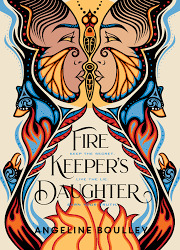
Genre:
Firekeeper's Daughter is a YA thriller (Printz winner category).
Target Age Group:
This book is intended for high-school age readers, generally 14 and up.
Summary:
Eighteen-year-old Daunis works hard to balance preparing for her future and caring for her family members, most of whom are members of the Ojibwe tribe. A number of tragedies have struck residents of the reservation recently and Daunis suddenly finds herself in a position to help uncover the truth about what is happening.
Justification:
Firekeeper's Daughter is a Printz Medal winner, received starred reviews from School Library Journal, Publisher's Weekly, and Booklist, and was named a "Best YA Book of All Time" by Time Magazine. I wanted to read it because I was aware that the book was both a critical and a popular success, and was particularly interested to learn it deals with the topic of missing and murdered Indigenous women, an issue I feel needs more media attention.
Evaluation:
For this book I will be evaluating plot, content, and language.
Plot:
Firekeeper's Daughter pulls the reader into the story from the very beginning. As with any good thriller, there are multiple twists and unexpected developments. Most of these feel fairly plausible, though toward the end I found I had to suspend disbelief a bit, but again, this is fairly common for the genre. The ending felt realistic if not completely satisfying, and all of the questions introduced as the story progresses are eventually answered.
Content:
This book covers some heavy topics, including sexual assault, murder, domestic abuse, historical atrocities perpetrated on Indigenous people, and even more. All of this is handled sensitively and honestly, and the issues included in the book are all based on problems currently affecting the Indigenous community. There is some horrific imagery in the book, descriptions of murder and suicide, and at one point Daunis is the person to discover the body of a missing girl. While nothing is graphically detailed, it would likely be too much for younger readers and perhaps some within the target audience.
Language:
Boulley is an enrolled member of the Ojibwe community, and lives in the area she used as a setting for her book. She incorporates some Anishinaabemowin dialogue into the story, which serves to highlight the separation between the Indigenous and White communities that Daunis navigates between daily. I found it helpful to listen to this story as an audiobook, so that I could hear the proper pronunciation and inflection of these words. Boulley also struck an authentic note in the way she has her characters speak differently based on the setting. Daunis is casual and sassy when interacting with friends and peers, and more formal and respectful with authority figures and her elders. This is a small detail, but I find it distracting when characters in a book have only one way of speaking, regardless of the context.
I found Firekeeper's Daughter to be enjoyable and thought-provoking. I appreciated hearing the aspects of tribal relations with United States government and the whitewashing of history from a writer who is a member of an affected community.
References
Boulley, A. (2021). Firekeeper's Daughter. Henry Holt and Co.
0 notes
Text
All Boys Aren't Blue, by George M. Johnson

Genre:
All Boys Aren't Blue is a YA memoir (banned or challenged book category).
Target Age Group:
This book is best for YA readers, generally age 15 and up.
Summary:
Author George Johnson shares his story of growing up Black and queer in New Jersey, through a lens of critical race theory and LGBTQIA+ activism.
Justification:
All Boys Aren't Blue is a New York Times bestseller, and was named a best book of the year in 2020 by New York Library, Chicago Public Library, and Kirkus Reviews. I was personally interested in it because I have seen it included on lists of books challenged in my local area.
Evaluation:
For this book I will be evaluating content, style and language, and cover.
Content:
I have read some frequently challenged books that left me wondering what the controversy is about, this is not one of them. George tells his story candidly and at times explicitly, including details of sexual encounters, assault, and experiences of racism and homophobia. None of this is related in a salacious manner however, and there is valuable reflection and a true spirit of education and advocacy throughout the story. The author includes a content warning at the beginning, including mention of sensitive topics and explanatory notes about specific racial and gay slurs that appear in the book. Overall, the content of All Boys Aren't Blue is appropriate for older teens and adults, and may be a helpful starting point for some important topics of discussion.
Style and language:
Johnson uses conversational and frank language throughout his memoir. Much of the time this style of writing lends an ease to his storytelling, and helps the reader to relate and feel as though they are really getting to know the author. At other times the words used can be uncomfortable for the reader, as when quotes from people who use offensive words to refer to Johnson's race or sexuality are repeated. He explains the context and reasons for the words' inclusion, and specifically states why they are not acceptable for common usage.
Cover:
All Boys Aren't Blue features an illustration of the author on the cover. Charly Palmer's depiction of Johnson features him in 3/4 profile with his eyes cut to the side as though he is looking back at the viewer. He wears an elaborate headdress of flowers, a nod to his defiance of gender norms and cultural expectations of Black men. The use of baby blue fading into pink hints at the theme of choosing what characteristics of gender feel comfortable for an individual rather than being forced into a binary system. The back cover proclaims, "be BOLD and BRAVE and QUEER", leaving no doubt as to the viewpoint from which the author is speaking. Finally, the summary on the jacket accurately represents the story Johnson is sharing.
The author explains that a big part of his motivation for telling his story is that he wanted to write the book that he needed when he was younger. Through his honesty and vulnerability, Johnson's words seem likely to fulfill his purpose for them. I imagine this book will help readers who share some of the identities Johnson embraces to feel seen and less alone. I also feel that it can help those from dissimilar circumstances to gain understanding and empathy for those who must navigate a world with rules very different from their own.
References
Johnson, G. M. (2020). All Boys Aren't Blue. Farrar Straus Giroux.
0 notes
Text
The Last Cuentista, by Donna Barba Higuera

Genre:
The Last Cuentista is a juvenile science fiction novel (Pura Belpre Honor winner category).
Target Age Group:
This book is best for middle grade readers, generally ages 10-14.
Summary:
Twelve-year-old Petra's family have been chosen as some of the few to flee a doomed Earth on space ships, and resettle a new planet hundreds of years of space travel away. When she awakens from the long journey in suspended animation, she finds humanity under the control of The Collective, a group determined to erase all differences and personality among humans.
Justification:
The Last Cuentista won The Pura Belpre Award and Newbery Medal, and appeared on "best of the year" lists from The Wall Street Journal, BookPage, School Library Journal, and Kirkus Reviews. I became interested in it after reading the synopsis of the unique plot on the jacket while browsing through books.
Evaluation:
For this book I will be evaluating characters, setting, and content.
Characters:
The story is told from Petra's point of view, and her understanding of events is appropriate for her age and would help make the story relatable to the intended reader. Petra shows change and growth over the course of the story. In the beginning she looks to her parents, or other adults, for help with her problems. As she experiences the events of the book she learns to trust her own feelings and become more independent. Other characters in the story are not as fully realized, in part because they appear almost exclusively in their relation to Petra.
Setting:
The world building in The Last Cuentista is thorough, with descriptions of what Petra is experiencing through all of her senses. The fanciful alien creatures, beautiful sights of space, and strange sounds, smells, and even tastes she encounters are all described in detail, giving the reader plenty of material for the imagination. Even more helpful, the reader is able to experience them as Petra does for the first time, and share in her feelings of confusion, awe, wonder. Hearing the story from her point of view, and in the present tense, adds to the feeling of immediacy and shared experience.
Content:
This book deals with themes of how individuality and creativity are vital to our humanity. These are developmentally appropriate for middle grade children, who are usually dealing with feelings of wanting to fit in with their peers while also discovering their own talents and interests. While the themes are easy to pick out, they are not explicitly stated or "dumbed down" for young readers. Instead, readers are allowed to form their own conclusions by experiencing the problems encountered by Petra and other characters.
This book is absorbing and enjoyable. While it has humor and some fantastical imagery, it also has substance and deals with important questions like, "What do the different generations of humanity owe each other?", "What is the relationship between individuality and equality?", and "What elements of humanity are most important?" The Last Cuentista is accessible and appropriate for middle grade readers, but I believe plenty of adults will enjoy it as well.
References
Higuera, D. B. (2021). The Last Cuentista. Levine Querido.
0 notes
Text
Hot Dog, by Doug Salati

Genre:
Hot Dog is a picture book (Caldecott Medal winner category).
Target Age Group:
This book is intended for elementary grade children, generally ages 5-10.
Summary:
Summer in the city is hectic, steamy, and loud! A refreshing day at the seaside is exactly what this hot dog needs.
Justification:
Hot Dog won the Caldecott Medal (2023), and received starred reviews from Publishers Weekly, Kirkus Reviews, and The Horn Book. I was personally drawn to the book's cover art and punny title.
Evaluation:
For this book I will be evaluating illustrations, style and language, and characters.
Illustrations:
It is easy to see why Hot Dog was awarded the Caldecott Medal. The illustration art is lovely, with rich colors and humorous details that will capture the interest of adults as well as children. A lot of the action is represented solely through the pictures, with only a few words, or even none, on many of the pages. The colors reinforce the contrast of the hot and anxious environment of the city with the cool and relaxing feeling of the seaside. I read this in a physical book format and feel that this is the best way to enjoy the artwork, especially the two-page spreads.
Style and Language:
The text of Hot Dog is simple and spare. The pages set in the city help to convey the frantic feel of the setting through short bursts of words punctuated with frequent exclamation points. In contrast, the seaside pages have flowing phrases, and some have no words at all, reflecting the peace and calm the characters feel.
Characters:
Neither of the characters in "Hot Dog", the dog and his owner, are named. The dog is the main character and the story is told from his viewpoint, resulting in a near-to-ground focus familiar to young children. The dog is anthropomorphized and very expressive in an endearing way. His owner is made relatable and likable mostly through the reader's observation of her bond with her dog. The two characters' interaction is heartwarming and engaging.
Hot Dog is a great book for reading aloud. The vivid illustrations would work well for reading to a classroom or library storytime group. The sweet and gentle story also makes it perfect for a bedtime story. Overall, I found this to be such an adorable book that I plan to buy a couple of copies for gifting to young relatives this holiday season!
References:
Salati, D. (2022). Hot Dog. (D. Salati, Illus.). Knopf.
0 notes
Text
Sam's Super Seats, by Keah Brown

Genre:
Sam' Super Seats is a contemporary realistic picture book (Disability or Differences category).
Target Age Group:
This book is best suited for elementary grade children, generally ages 5-10.
Summary:
Sam has a lot in common with her best girlfriends; the same grade at school, a love of shopping, cool dance moves! Sam also has cerebral palsy, and she knows all the best seats for a quick rest when her body needs it.
Justification:
Kirkus Reviews calls Sam's Super Seats, "a warmhearted, necessary affirmation of disability and self-love through a multifaceted, endearingly imaginative narrator." (2022). School Library Journal says the book is, "Recommended for all those teaching acceptance and tolerance in all aspects of life." (McMahon, 2022). I was personally intrigued by this book because my own daughter has cerebral palsy, and I have noticed a lack of books that directly acknowledge and address disability.
Evaluation:
For this book I will be evaluating illustrations, characters, and content.
Illustrations:
Sharee Miller's beautiful pencil and watercolor illustrations fill Sam's Super Seats with cheer and whimsy. The pictures are visually interesting, with lots of color and details that add to the realism of the story. The characters' faces are expressive in a way that may help younger children to relate to their points of view. In the story Sam describes how she anthropomorphizes the various seats she uses, assigning personalities to them. The drawings of the furniture reflect this, with friendly looking curvy lines and inviting backgrounds that reinforce the story's message that self-care and rest are things to be enjoyed rather than avoided.
Characters:
This is a joyful story, and the characters' attitudes reflect that. Sam, the main character, shares details of her life, including accomplishments and challenges in a matter-of-fact and upbeat manner. While Sam specifically talks about her disability, it does not define her, she details her likes and dislikes, and discusses things that she feels she is good at. Sam's friends are described mostly in terms of their similarities with each other and herself, which is typical of children this age.
Content:
One of the best things about Sam's Super Seats is the story's normalization of disability. Having Sam narrate is respectful of the right of people to define their own identities and share their own stories. The book deals with Sam's limitations honestly, rather than presenting a common and well-intentioned but false claim that disability makes no difference in a person's life. While Sam acknowledges her unique challenges, she does so in an accepting and optimistic tone.
This book does a great job of explaining the special needs accompanying a disability in a way that is accessible to young readers. The emphasis on Sam's similarities with her friends and on her positive self-image represent Sam as an individual but also a typical kid. Stories like this can help children to empathize with those with physical differences, and may offer a chance for caregivers to answer questions and start discussions about the topic. Sam's Super Seats also provides a positive representation for children with disabilities who may not often see this aspect of themselves reflected in picture books.
References:
Brown, K. (2022). Sam's Super Seats. (S. Miller, Illus.). Kokila.
Kirkus Reviews. (2022, May 10). Sam's Super Seats: A spirited celebration of self-confidence and self-care. [Review of the book Sam's Super Seats, by K. Brown].
McMahon, B. (2022, July 29). [Review of the book Sam's Super Seats, by K. Brown]. School Library Journal. https://www.slj.com/review/sams-super-seats
0 notes
Text
Titles I Have Reviewed
Bea Wolf, by Zach Weinersmith
Pizza: A Slice of History, by Greg Pizzoli
Dear Mothman, by Robin Gow
Scythe, by Neal Shusterman
Brooms, by Jasmine Walls and Teo DuVall
Firekeeper's Daughter, by Angeline Boulley.
All Boys Aren't Blue, by George M. Johnson
The Last Cuentista, by Donna Barba Higuera
Hot Dog, by Doug Salati
Sam’s Super Seats, by Keah Brown
The Girl With a Mind for Math, by Julia Finley Mosca
Fugly, by Claire Waller
Willodeen, by Katherine Applegate
Before She Was Harriet, by Lesa Cline-Ransome
White Bird, by R. J. Palacio
0 notes
Text
The Girl With a Mind for Math: The Story of Raye Montague, by Julia Finley Mosca
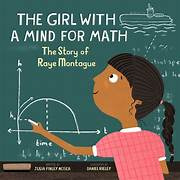
Genre:
The Girl With a Mind for Math is a non-fiction picture book (informational or biography category).
Target Age Group: This book is written for elementary grade readers, generally ages 5-10.
Summary: The Girl With a Mind for Math tells the true story of Raye Montague, an African American woman who became a design engineer for the United States Navy in the 1960s. The book covers Montague's education and career from the time she was in elementary school though her retirement.
Justification:
This book was awarded the Amelia Bloomer Book List Award by the American Library Association in 2019, and received a starred review from Kirkus Reviews.
Evaluation:
For this book I will be evaluating the illustrations, content, and style and language.
Illustrations:
The Girl With a Mind for Math is illustrated by Daniel Rieley and features rich colors and a simple, somewhat whimsical style. The drawings of classic "lollipop shaped" trees and people with one-line smiles on their faces give the feeling of children's art in a way that might make the book feel more familiar and accessible to young people than the subject matter would generally suggest. Even the impersonal and industrial machines depicted, including a submarine and an early computer, somehow look cheerful and approachable in these delightful illustrations.
Content
This book focuses on the hard work and accomplishments of Montague, but it does so while addressing the barriers she faced as a result of the blatant racism and sexism of her time. In child-appropriate language the story explains how the system of the time was "unjust" and "deplorable" and the negative effects that it had. At the end of the book there are helpful references including a timeline, bibliography, and an interview with Montague.
Style and Language
The Girl With a Mind for Math is written in verse, which adds to an overall fun and upbeat tone. Some of the rhymes feel slightly awkward and forced, but most flow well and have a fun energy and momentum. Word choices are specific and accurate enough to introduce some new vocabulary to younger children, but not so advanced as to be frustrating or difficult to understand.
This book hits the sweet spot between educational and entertaining. The fun illustrations and bouncy verse make it perfect for reading aloud either at home or in the classroom. The reference materials included can help caregivers or teachers to answer questions and expand on the topics for further learning.
References:
American Library Association. (2023). https://www.ala.org/awardsgrants/girl-mind-math-story-raye-montague
Kirkus Reviews. (2018, July 15). The Girl With a Mind for Math: The Story of Raye Montague: A fun read and an uplifting story. [Review of the book The Girl With a Mind for Math: The Raye Montague Story, by J. F. Mosca].
Mosca, J. F. (2018). The Girl With a Mind for Math: The Story of Raye Montague (D. Rieley, Illus.). The Innovation Press.
0 notes
Text
Fugly by Claire Waller

Genre:
Fugly is a young adult (YA) novel (LGBTQ+ category).
Target Age Group:
This book is written for YA readers, generally ages 14-18.
Summary:
Fugly tells the story of Beth, an isolated and unhappy 19-year-old living at home with her chronically ill mother and rebellious younger brother. Beth spends most of her time on social media, teaming up with online friend Tori to troll and harass the "beautiful people" she envies and despises. Things change when Beth sees the real-life effects of her online bullying, but Tori doesn't want to let her stop.
Justification:
Reviews from Publisher's Weekly and Kirkus are generally positive for Fugly, praising the book's handling of important topics like cyberbullying, body-shaming, self-harm and disordered eating.
Evaluation:
For this book I will be evaluating characters, content, and plot.
Characters:
One interesting thing about Fugly is that that main character/narrator, Beth, is pretty unlikeable, at least through the first few chapters of the book. As the story progresses the reader is able to see first, the causes behind many of Beth's antisocial behaviors (online bullying, lying, judgmental attitudes about other people), and next, that she is an unreliable source when it comes to information about herself due to her poor self-image. While the characters do sometimes fall into stereotypical behavior, (Beth is overweight and also obsessed with food, her new friend Amy is beautiful but doesn't realize it), they also have dimension and clear motivations. Nearly all of the characters make mistakes and try to correct them, and show personal growth over the course of the story.
Content:
Fugly deals with some intense and potentially upsetting topics, including disordered eating, self harm, depression and anxiety, cyber-bullying, and sexual assault. The subjects are important and relevant to the intended reader group and are made more relatable by the main characters' involvement with them. There are lessons learned throughout the story, but they are presented in a realistic way. Characters make mistakes and learn from them, in much the same way that most lessons in life are learned. The book respects the reader by allowing them to observe and recognize most of the issues going on in the story without explicitly naming or explaining them.
Plot:
The plot of Fugly is developed at a generally good pace. The action that will drive the story begins within the first few pages and draws the reader in with unexpected developments. In contrast, the ending is somewhat predictable and feels a bit rushed, while still managing to feel unsatisfying, as one of the main questions, "Who is Tori?" remains unanswered. The events of the story are generally believable, though the ending is a little bit more fantastical, and the characters actions make sense given their motivations and personalities.
Overall, this book deals with issues relevant to teens, and features just enough intrigue and tension to keep the reader engaged. Due to some of the subject matter, and the fact that the main characters are beginning college students, Fugly is best suited to older teens. I read this book as an e-book on my Kindle, and found that it was the perfect sort of book for this format, as there were no pictures or graphics, and the straightforward plot did not require any scrolling back and forth to refer to past pages.
References:
Kirkus. (2019, August 12). Fugly: Doesn't shy away from the dark side of young adulthood and the insecurity that can drive a smart teen to extremes. [Review of the book Fugly, by C. Waller]. Kirkus Reviews. https://www.kirkusreviews.com/book-reviews/claire-waller/fugly/
Publisher's Weekly. (2029, September 26). [Review of the book Fugly, by C. Waller] https://www.publishersweekly.com/9781541544994
Waller, C. (2019). Fugly. Carolrhoda Lab.
0 notes
Text
Willodeen by Katherine Applegate
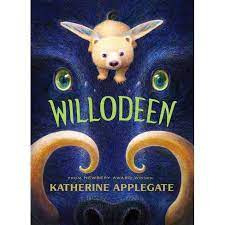
Genre:
This is a middle grade fantasy fable (Bluebonnet winner category).
Target Age Group:
Willodeen is written for middle grade readers, generally ages 8-12.
Summary:
Animal-loving Willodeen lives with her adoptive mothers, Mae and Birdie, in the town of Perchance. Something has upset the balance of nature lately; wildfires, (like the one that killed her family), are becoming common and creatures that were once plentiful are now scarce. With the help of her new friend Connor, Willodeen is determined to figure out the cause and hopefully help fix it.
Justification:
Willodeen received starred reviews in Booklist and Publishers Weekly, and was awarded the Bluebonnet Award by the Texas Library Association.
Evaluation:
For this book I will be evaluating characters, style and language, and theme.
Characters
The main characters in Willodeen have depth, meaning they have multifaceted personalities and their actions and motivations generally make sense. They are flawed but basically good. Most characters, including those who remain in the background, show believable growth over the course of the story. Willodeen herself becomes more assertive and willing to speak up to adults around her, Connor's father becomes more tolerant and willing to listen to Conner and Willodeen, even the nameless townspeople come to understand the effect of their actions on their environment, and work to protect it. Willodeen and Connor are 11, close to the age of the typical reader, and their challenges are relatable for this age group, including frustration about getting grownups to listen, awkward feelings about making friends, and reluctance to do schoolwork. These everyday concerns against the backdrop of the larger events in the story could help young readers to picture themselves in the same circumstances.
Style and Language
Willodeen uses varied and expressive language, especially when describing the natural world, which is at the heart of the story. Figurative language is used to great effect, helping the reader to really imagine the world of the story. For instance, the animals known as screechers are not just said to be smelly, but as stinking like, "a hundred rotten eggs", "dead fish and a splash of skunk." The story is told in the first person, from Willodeen's perspective. The vocabulary and level of perceptiveness make sense for someone of her age.
Theme
The themes of Willodeen are that everything in nature is interrelated, and that it is important to respect and care for the environment. The themes are shown through the events of the story; one of the species of animals prized by the town is disappearing, and Willodeen discovers how the actions of the town's residents are causing it. As she observes the world around her and solves the mystery of what is happening, the readers are invited to reach the same conclusions as the main characters.
I listened to Willodeen as an audiobook through my library. The reader, Ariadne Meyers, expresses emotion clearly throughout the story. She also lends different voices to the main characters, and makes it easy to tell who is "speaking" at any point. Both of these qualities help the listener to follow the storyline, and also make for an enjoyable experience. When perusing a print copy of the book, I did notice that I had missed out on some lovely illustrations by Charles Santoso, a factor that readers may wish to consider when picking a reading format. However, I also believe there is some merit in allowing the reader to develop their own vision of what the fantastical animals of the story look like.
References
Applegate, K. (2021). Willodeen. (C. Santoso, Illus.). Feiwel and Friends.
0 notes
Text
Before She Was Harriet by Lesa Cline-Ransome
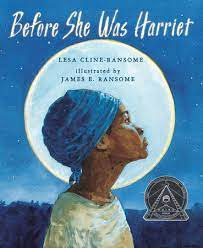
Genre:
This is a picture book biography (Coretta Scott King winner category).
Target Age Group:
Before She Was Harriet is written for elementary aged children, usually ages 5-11.
Summary:
Before She Was Harriet tells the life story of Harriet Tubman. The events of her life are told in reverse order, with each phase being described through the many roles she inhabited, including suffragist, spy, nurse, rescuer, and enslaved person.
Justification:
Besides winning the Coretta Scott King award, this book is also a Jane Addams Children's Honor book, a Junior Library Guild selection, and received starred reviews in Publisher's Weekly, Kirkus Reviews, and Booklist.
Evaluation:
For this book I will be reviewing the illustrations, style & language, and content.
Illustrations
James E. Ransome's watercolor illustrations fill every page with rich color. The most prominent colors are yellow and blue. Yellow draws attention to challenges and hardships, such as the fiery torches and yellow dirt road pictured with the confederate army, the yellow walls of the makeshift hospital, and the yellow banner of the suffragists. A contrasting deep blue is used to show the night skies and water surrounding the boats for scenes depicting escape and freedom or peaceful reflection. Harriet is shown wearing blue in every illustration. While this specific symbolism might not be apparent to children, the distinction of the colors used adds to the mood of each scene.
Style and Language:
Before She Was Harriet is written in free verse. The writing has a lyrical quality to it, and lends itself well to being read aloud, perfect for the target audience. The phrase, "Before she was. . ." repeats throughout the story, highlighting the many roles Tubman filled in her life. There is no punctuation in the text, which adds to the feeling of flow and connection from one line to the next. While many words are used to describe Tubman, the very last word in the book is "free", emphasizing the value that she dedicated her life to.
Content
This book does not shy away from or sugarcoat the difficult subject matter of slavery and war. It uses simple and straightforward phrases such as "hatred and fear" and "bloodied dirt" and speaks of "slave owner(s)" who "punished her with lashes". This frankness shows respect readers of all ages and for the subject of the book. Before She Was Harriet begins with Harriet as an old woman, and works its way backward chronologically through her life. This reversed timeline serves to make her story all the more inspiring as the reader is led from her great accomplishments to her challenging first circumstances.
Before She Was Harriet is a simple and quick read, and could be a good introduction for young children to the topics of slavery and the Civil War. The beautiful illustrations and text in verse are sophisticated enough to hold the attention of older students as well, and might be a good component for related history lessons. For this reason it would be a valuable addition to classroom or home libraries.
References
Cline-Ransome, L. (2017). Before She Was Harriet (J. E. Ransome, Illus.). Holiday House.
0 notes
Text
White Bird by R. J. Palacio

Genre:
This is a historical fiction graphic novel (historical fiction category).
Target Age Group:
White Bird is intended for middle grade readers, generally ages 9-14.
Summary:
White Bird is a story within a story. The narrator is the grandmother of Julian, who readers might remember as the bully from the author's bestselling novel Wonder. Julian's grandmother tells him the story of how she survived the Nazi occupation of France with the help of a classmate's family, who hid her in the hayloft of their barn.
Justification:
White Bird received a starred review from Kirkus, was named a New York City Public Library Best Book of the Year, and was "highly recommended" in a review from the Jewish Book Council (Schnieder, 2019).
Evaluation:
For this review I will be evaluating the characters, illustrations and content.
Characters
The main characters, Julian, his grandmother, and her schoolmate/rescuer, all show change and personal growth over the course of the story. Supporting characters are generally flatter, depicted as either good or bad, with little nuance or complication about them. The main characters are also close in age to the intended audience of the book, and dealing with typical issues for their age. Even with the dramatic events which provide the backdrop for the main characters' personal stories, their everyday emotions and struggles are still taken seriously and treated with respect, which may help young readers to see themselves in the characters.
Illustrations
Kevin Czap's illustrations are beautiful and colorful, conveying great emotion through relatively simple art. The monotony of the main character's daily life is conveyed through repetitive sketches depicting her stark hiding place. As the setting shrinks, closeups of the character's faces lend an almost claustrophobic feeling to the story. These scenes are contrasted with dream or fantasy sequences with beautiful, vibrant illustrations, letting the reader share in the character's feelings of reprieve and momentary escape.
Content
In an interview with Anjali Enjeti, author R. J. Palacio explained one of her reasons for writing White Bird, “We need an age-appropriate curriculum in school that highlights how people are singled out and scapegoated and must do more to introduce students to historical events—the good and the bad." (Enjeti, 2019). This book tells the story of the holocaust from a victim-centered viewpoint, and on a level appropriate for middle grade students. The end of the book also draws parallels from history to current events and encourages readers to engage with causes they believe in. This story could provide a great opening for discussions about some difficult and complex subjects including racism, disability, and political protest.
While White Bird is written for middle grade aged children, it is written and illustrated well enough to be enjoyable and engaging for adults too. The content is not graphic but due to the subject matter, children reading it might benefit from processing it with a teacher or adult family member.
References
Enjeti, A. (2019, October 1). Wonder Author R.J. Palacio Discusses Her Graphic Novel of the Holocaust, White Bird. Kirkus. https://www.kirkusreviews.com/news-and-features/articles/wonder-author-rj-palacio-discusses-her-graphic-nov/
Palacio, R. J. (2019). White Bird (K. Czap Illus.). Knopf.
Schnieder, E. (2019, October 10). Review: White Bird: A Wonder Story. Jewish Book Council. https://www.jewishbookcouncil.org/book/white-bird-a-wonder-story
0 notes
